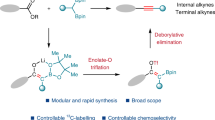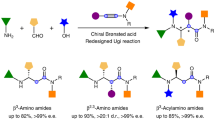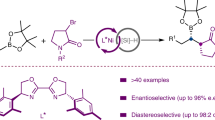Abstract
α-Branched amines are present in hundreds of pharmaceutical agents and clinical candidates and are important targets for synthesis. Here, we show the convergent synthesis of α-branched amines from three readily accessible starting materials: aromatic C–H bond substrates, terminal alkenes and aminating agents. This reaction proceeds by an intermolecular formation of C–C and C–N bonds at the sp3 carbon branch site through an uncommon 1,1-alkene addition pathway. The reaction is carried out under mild conditions and has high functional group compatibility. Ethylene and propylene feedstock chemicals are effective alkene inputs, with ethylene in particular providing for the one-step synthesis of α-methyl branched amines, a motif prevalent in drug structures. The reaction is scalable and 1% loading of an air-stable dimeric rhodium precatalyst is effective for several different types of products. The use of chiral catalysts also enables the asymmetric synthesis of α-branched amines.
This is a preview of subscription content, access via your institution
Access options
Access Nature and 54 other Nature Portfolio journals
Get Nature+, our best-value online-access subscription
$29.99 / 30 days
cancel any time
Subscribe to this journal
Receive 12 digital issues and online access to articles
$119.00 per year
only $9.92 per issue
Buy this article
- Purchase on Springer Link
- Instant access to full article PDF
Prices may be subject to local taxes which are calculated during checkout






Similar content being viewed by others
Data availability
Much of the data that support the results of this study are available in the Supplementary Information. Additional data are available from the corresponding author upon reasonable request. X-ray crystal data for structure 62 that established its absolute configuration are shown in Supplementary Fig. 9, Supplementary Tables 7–13 and are available free of charge from the Cambridge Crystallographic Data Centre (https://www.ccdc.cam.ac.uk/) under reference no. CCDC 1903974.
References
Maciejewski, A. et al. DrugBank 5.0: a major update to the DrugBank database for 2018. Nucleic Acids Res. 46, D1074–D1082 (2017).
Nugent, T. C. & El-Shazly, M. Chiral amine synthesis—recent developments and trends for enamide reduction, reductive amination and imine reduction. Adv. Synth. Catal. 352, 753–819 (2010).
Li, W. & Zhang, X. (eds) Stereoselective Formation of Amines Vol. 343 (Topics in Current Chemistry, Springer, 2014).
Yang, Y., Shi, S.-L., Niu, D., Liu, P. & Buchwald, S. L. Catalytic asymmetric hydroamination of unactivated internal olefins to aliphatic amines. Science 349, 62–66 (2015).
Blakemore, D. C. et al. Organic synthesis provides opportunities to transform drug discovery. Nat. Chem. 10, 383–394 (2018).
Roizen, J. L., Harvey, M. E. & Du Bois, J. Metal-catalyzed nitrogen-atom transfer methods for the oxidation of aliphatic C–H bonds. Acc. Chem. Res. 45, 911–922 (2012).
Zhou, Y., Engl, O. D., Bandar, J. S., Chant, E. D. & Buchwald, S. L. CuH-catalyzed asymmetric hydroamidation of vinylarenes. Angew. Chem. Int. Ed. 57, 6672–6675 (2018).
Lovering, F., Bikker, J. & Humblet, C. Escape from flatland: increasing saturation as an approach to improving clinical success. J. Med. Chem. 52, 6752–6756 (2009).
Schmidt, F., Stemmler, R. T., Rudolph, J. & Bolm, C. Catalytic asymmetric approaches towards enantiomerically enriched diarylmethanols and diarylmethylamines. Chem. Soc. Rev. 35, 454–470 (2006).
Robak, M. T., Herbage, M. A. & Ellman, J. A. Synthesis and applications of tert-butanesulfinamide. Chem. Rev. 110, 3600–3740 (2010).
Tsai, A. S., Tauchert, M. E., Bergman, R. G. & Ellman, J. A. Rhodium(iii)-catalyzed arylation of Boc-imines via C−H bond functionalization. J. Am. Chem. Soc. 133, 1248–1250 (2011).
Li, Y. et al. Rhodium-catalyzed direct addition of aryl C–H bonds to N-sulfonyl aldimines. Angew. Chem. Int. Ed. 50, 2115–2119 (2011).
Yang, Y., Perry, I. B. & Buchwald, S. L. Copper-catalyzed enantioselective addition of styrene-derived nucleophiles to imines enabled by ligand-controlled chemoselective hydrocupration. J. Am. Chem. Soc. 138, 9787–9790 (2016).
Hummel, J. R., Boerth, J. A. & Ellman, J. A. Transition-metal-catalyzed C–H bond addition to carbonyls, imines and related polarized π bonds. Chem. Rev. 117, 9163–9227 (2017).
Heinz, C. et al. Ni-catalyzed carbon–carbon bond-forming reductive amination. J. Am. Chem. Soc. 140, 2292–2300 (2018).
Trowbridge, A., Reich, D. & Gaunt, M. J. Multicomponent synthesis of tertiary alkylamines by photocatalytic olefin-hydroaminoalkylation. Nature 561, 522–527 (2018).
McNally, A., Prier, C. K. & MacMillan, D. W. C. Discovery of an α-amino C–H arylation reaction using the strategy of accelerated serendipity. Science 334, 1114–1117 (2011).
Zuo, Z. et al. Merging photoredox with nickel catalysis: coupling of α-carboxyl sp 3 carbons with aryl halides. Science 345, 437–440 (2014).
Shaw, M. H., Shurtleff, V. W., Terrett, J. A., Cuthbertson, J. D. & MacMillan, D, W. C. Native functionality in triple catalytic cross-coupling: sp 3 C–H bonds as latent nucleophiles. Science 352, 1304–1308 (2016).
Jain, P., Verma, P., Xia, G. & Yu, J.-Q. Enantioselective amine α-functionalization via palladium-catalysed C–H arylation of thioamides. Nat. Chem. 9, 140–144 (2017).
Liao, L., Jana, R., Urkalan, K. B. & Sigman, M. S. A palladium-catalyzed three-component cross-coupling of conjugated dienes or terminal alkenes with vinyl triflates and boronic acids. J. Am. Chem. Soc. 133, 5784–5787 (2011).
Nelson, H. M., Williams, B. D., Miró, J. & Toste, F. D. Enantioselective 1,1-arylborylation of alkenes: merging chiral anion phase transfer with Pd catalysis. J. Am. Chem. Soc. 137, 3213–3216 (2015).
Guimond, N., Gorelsky, S. I. & Fagnou, K. Rhodium(iii)-catalyzed heterocycle synthesis using an internal oxidant: improved reactivity and mechanistic studies. J. Am. Chem. Soc. 133, 6449–6457 (2011).
Patel, P. & Chang, S. N-substituted hydroxylamines as synthetically versatile amino sources in the iridium-catalyzed mild C–H amidation reaction. Org. Lett. 16, 3328–3331 (2014).
Park, Y., Kim, Y. & Chang, S. Transition metal-catalyzed C–H amination: scope, mechanism and applications. Chem. Rev. 117, 9247–9301 (2017).
Park, Y., Park, K. T., Kim, J. G. & Chang, S. Mechanistic studies on the Rh(iii)-mediated amido transfer process leading to robust C–H amination with a new type of amidating reagent. J. Am. Chem. Soc. 137, 4534–4542 (2015).
Lafrance, M. & Fagnou, K. Palladium-catalyzed benzene arylation: incorporation of catalytic pivalic acid as a proton shuttle and a key element in catalyst design. J. Am. Chem. Soc. 128, 16496–16497 (2006).
Piou, T. & Rovis, T. Rhodium-catalysed syn-carboamination of alkenes via a transient directing group. Nature 527, 86–90 (2015).
Weissermel, K. & Arpel, H. J. in Industrial Organic Chemistry 59–89 (Wiley-VCH, 2003).
Ye, B. & Cramer, N. Chiral cyclopentadienyl ligands as stereocontrolling element in asymmetric C–H functionalization. Science 338, 504–506 (2012).
Hyster, T. K., Knörr, L., Ward, T. R. & Rovis, T. Biotinylated Rh(iii) complexes in engineered streptavidin for accelerated asymmetric C–H activation. Science 338, 500–503 (2012).
Trifonova, E. A. et al. A planar-chiral rhodium(iii) catalyst with a sterically demanding cyclopentadienyl ligand and its application in the enantioselective synthesis of dihydroisoquinolones. Angew. Chem. Int. Ed. 57, 7714–7718 (2018).
Satake, S. et al. Pentamethylcyclopentadienyl rhodium(iii)–chiral disulfonate hybrid catalysis for enantioselective C–H bond functionalization. Nat. Catal. 1, 585–591 (2018).
Newton, C. G., Kossler, D. & Cramer, N. Asymmetric catalysis powered by chiral cyclopentadienyl ligands. J. Am. Chem. Soc. 138, 3935–3941 (2016).
Li, L., Jiao, Y., Brennessel, W. W. & Jones, W. D. Reactivity and regioselectivity of insertion of unsaturated molecules into M–C (M = Ir, Rh) bonds of cyclometalated complexes. Organometallics 29, 4593–4605 (2010).
Simmons, E. M. & Hartwig, J. F. On the interpretation of deuterium kinetic isotope effects in C–H bond functionalizations by transition-metal complexes. Angew. Chem. Int. Ed. 51, 3066–3072 (2012).
Lei, H. & Rovis, T. Ir-catalyzed intermolecular branch-selective allylic C–H amidation of unactivated terminal olefins. J. Am. Chem. Soc. 141, 2268–2273 (2019).
Knecht, T., Mondal, S., Ye, J.-H., Das, M. & Glorius, F. Intermolecular, branch-selective and redox-neutral Cp*Ir(iii)-catalyzed allylic C–H amidation. Angew. Chem. Int. Ed. 58, 7117–7121 (2019).
Burman, J., Harris, R., Farr, C., Bacsa, J. & Blakey, S. B. Rh(iii) and Ir(iii)Cp* complexes provide complementary regioselectivity profiles in intermolecular allylic C–H amidation reactions. ACS Catal. 9, 5474–5479 (2019).
Acknowledgements
This work was supported by the NIH (R35GM122473). The authors thank B. Mercado (Yale University) for solving the crystal structure of 62 and E. Paulson (Yale University) for stereochemical assignment of 64 using NMR methods.
Author information
Authors and Affiliations
Contributions
S.M. and T.J.P. developed the reaction conditions, completed the scope and designed mechanistic experiments. S.M. co-prepared the manuscript with T.J.P. J.A.E. co-conceived the concept and co-prepared the manuscript with feedback from S.M. and T.J.P.
Corresponding author
Ethics declarations
Competing interests
The authors declare no competing interests.
Additional information
Publisher’s note: Springer Nature remains neutral with regard to jurisdictional claims in published maps and institutional affiliations.
Supplementary information
Supplementary Information
Supplementary Tables 1–13, Supplementary Figs, 1–9, Supplementary methods, Supplementary references
compound 62
Crystallographic Data for compound 62.
Rights and permissions
About this article
Cite this article
Maity, S., Potter, T.J. & Ellman, J.A. α-Branched amines by catalytic 1,1-addition of C–H bonds and aminating agents to terminal alkenes. Nat Catal 2, 756–762 (2019). https://doi.org/10.1038/s41929-019-0330-7
Received:
Accepted:
Published:
Issue Date:
DOI: https://doi.org/10.1038/s41929-019-0330-7
This article is cited by
-
Late-stage synthesis of heterobifunctional molecules for PROTAC applications via ruthenium-catalysed C‒H amidation
Nature Communications (2023)
-
Rhodium-catalyzed enantio- and diastereoselective carboamidation of bicyclic olefins toward construction of remote chiral centers and axis
Science China Chemistry (2023)
-
Catalyst-controlled enantioselective 1,1-arylboration of unactivated olefins
Nature Catalysis (2020)



